Sims class Destroyers (1938)
 US Navy Fleet Destroyers (1937-47): USS Sims, Hugues, Anderson, Hamman, Mustin, Russel, O’Brien, Walke, Morris, Roe, Wainwright, Buck
US Navy Fleet Destroyers (1937-47): USS Sims, Hugues, Anderson, Hamman, Mustin, Russel, O’Brien, Walke, Morris, Roe, Wainwright, Buck
These 12 ships were the last US prewar destroyers class (completed before Dec. 1941). They marked a turning point, leaving behind theoretical considerations and naval staff ideas for a more pragrmatic approach, both dictated by captains reports and taking advantage of tonnages revisions brought by the the Second London Naval Treaty in 1935, lifting some limits. Not to start completely anew, it was chosen to base the new tonnage on the previous Benham class, being 70 tons more and pregmatic in their approach, notably making a return to artillery versus torpedo load. All Sims-class destroyers saw heavy action in WW2 on all theaters, with almost half lost in combat, and accumulating 91 battle stars.
The last prewar US destroyers
The twelve Sims class were the continuation of the Mahan, but with many differences: They marked a new standard, away from the mistakes of the previous Gridley-Bagley-Benham.
In 1937, when their genesis began, the second treaty of London was ratified, which noted limitations in tonnage for destroyers, both global and with a reevaluated displacement of 3,000 tons. The Sims were studied by the CNO (Chief of Naval Operations), formulating a new standard based on existing design’s experiences and reports. The new design was to leave the prevailing theoretical system so far (notably the heavy torpeo tubes load). Instead, critics and wishes of destroyers commanders was taken in account and they would be more pragmatic in their approach.
Paradoxically, the tonnage boost still was combined with four torpedo tube banks and they ended better armed, larger and heavier, but still on a 1500 tons base and so the design was already theoretically unstable. Stability problems were only solved, at the cost of many modifications advocated by the newly established Bureau of Ship (BuShips).
The Bureau of Ships was setup in 1940 and replaced the two competing organizations (Bureau of Ships and Repairs or BuC&R and Bureau of Engineering or BuEng). A third one, the Bureau of Ordnance, still took care of the equipments, armor, guns and mounts, and also intervened on its field during the design phase.
The start was poor communication between the two. Indeed, the new class were increased by 8 feet (2.4 m) in hull length to take advantage of the extra tonnage (with benefits on seaworthiness -by better coping with wavelenghts-, speed -by increasing the hull ratio- and range -by having more space for bunkerage). Thus started a trend of upsizing, later trigerred by the fall of all lmits -war obliges- leading to the 2100-ton destroyers of wartime. The Bensons and Gleaves, and of course the Fletchers.
The class was designed by Gibbs & Cox of New York, already behind many innovative destroyer designs. They incorporated streamlining of the bridge structure, forward hull, to further increase speed, improving fuel economy while keeping roughly the same machinery arrangement as before, but with a more powerful powerplant (which ended heavier as well). Based on captains demands, they managed to add an additional 5-inch gun. However torpedo tubes were rearranged in a trio, two broadside quad banks and one elevated on centerline, keeping the 8 torpedo broadside, but no longer the theoretical forward launch of 12 torpedoes (16 before).
Implicated in these debates, the Admiralty Board also wanted a fifth gun according to a specific design: They wanted destroyers tailored for the Pacific. The fifth 5-in (127 mm) gun was required to better face the “special type” IJN destroyers. In addition, these main guns were partly in enclosed turrets; The two superfiring forward and the aftmost. As for machinery they kept the single funnel of past designs.
So what was wrong ?
When USS Anderson, the first of the class to be delivered in February 1939 was inspected at Federal Shipbuilding, Kearny, New Jersey, it was found to be 150 tons overweight, and thus dangerously top-heavy due to insufficient metacentric height already before making her sea trials. This trigerred an order to stop construction of the whole serie while a complete redesign and even rebuilding of the class (so delays and costs). This infuriated both the president and Navy state secretary, Charles Edison.
It was decided out of emergency to drop one of the 5-inch (127 mm) guns, the third, and rearranged the torpedo tubes. One side mount was removed, the other relocated to the centerline, so having two quadruple centerline, but elevated on the structure. This has been an underestimation by the Bureau of Engineering, of the weight of a new machinery design and the Bureau of Construction and Repair did not have sufficient authority to detect or correct the error during the design process… Secretary of the Navy Charles Edison thus also proposed to have the two bureaus merged into the “Bureau of Ships”. However as the two bureau chiefs could not agree he fired them in September 1939. The administrative change was ratified by a law passed by Congress on 20 June 1940. A single entity will prevent from now on any miscommunication and ensured this mishap never happen again.
Detailed Design:
Eventually the new design was approved, changed were made and construction resumed (see later).
Hull and general design
The Sims class displaced still 1,570 tons (light standard) but for 2,293 tons (full load) so more than the previous designs, with a 348 ft 3 in (106.15 m) hull overall, 36 ft 1 in (11 m) in beam and 13 ft 4 in (4.06 m) in draft. The rest was pretty much a repeat of the Benhams, with a single pol mast aft of their redesigned bridge. The latter was probably the most thought after part of the design, as per Gibbs & Cox work. instead of the classic triangular shaped generous winged bridge from the past (first adopted by the Farraguts and repeated since, inherited from the Flush Deckers and going back way before), they chose a completely different approach, dictated by speed: A streamlined bridge.
Also they choose to drop the generous “glasshouse” which made great view in peacetime, but was a hinderance in case of combat. In heavy weather it was not unheard of of these shattering, and in cas of wartime, they would have been the source of glass shards projected inside, thus injuring all key personal. Instead, captained asked for smaller apertures, arguing that they would in normal times rather be on the wings. The end result was a unique combination of a rounded bridge with portholes (less glass, mor eprotection and rigidity) wich proved more economical also, still an open bridge above, and two also streamlined wings, but extending not further than the sides of the forward superstructure. That style of bridge was repeated on the Bensons, Gleaves and Fletcher, before being changed on the Sumner/Gearing. The prow was still rather tall for seaworthiness, the changes being mostly in the hull entry lines. Portholes were kept also.
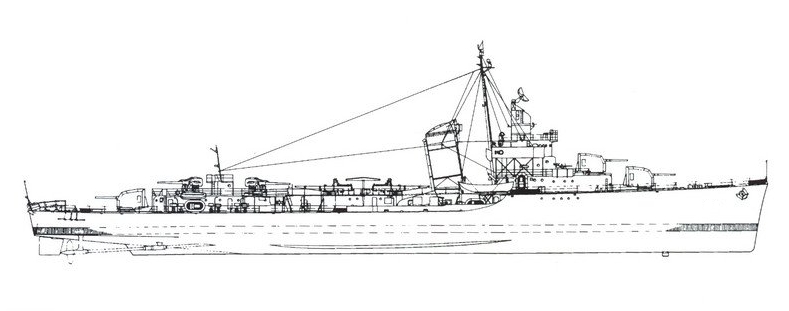
USS Russel in 1943. Note she kept N°3 main gun.
Powerplant
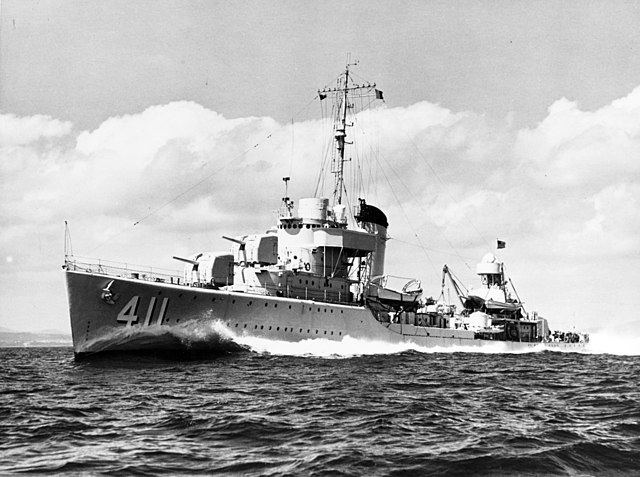
First destroyer completed, USS Anderson in sea trials, 1939.
The Sims nearly duplicated the advanced machinery of the preceding Benham class. They had boiler rooms adjacent forward, engine rooms adjacent aft, one funnel. This was the last time this arrangement was repeated. Steam pressure was still 600 psi (4,100 kPa) (sometimes 565 psi in sources perhaps a builder’s variation). That spea was superheated to 715 °F (379 °C) and boiler economizers added as well as double reduction gearing by Westinghouse plus cruising turbines. The while panoply ensure better efficiency for range, maintained great speed, with a base output of 51,138 shp (38,134 kW) in trials versus 49,250 shp (36,730 kW) for the Benhams. Net result was a speed on 37 knots (69 km/h; 43 mph) on trials, versus 37.9 knots (70.2 km/h; 43.6 mph) on trials so not that great a gain for having less torpedoes nor more guns in the end.
As for range, they were still able to travel 5,640 nmi (10,450 km; 6,490 mi) at 12 knots (22 km/h; 14 mph) versus 5,390 nmi (9,980 km; 6,200 mi) at the same, so not that great improvement either. Apart the design bridge in general, there was not much to like as for improvements on this class.

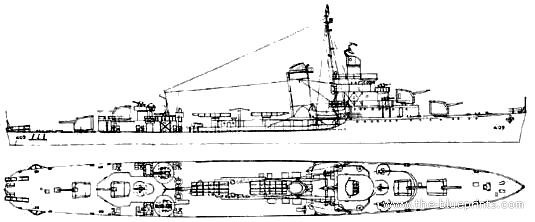
The class in 1939 and 1942
Armament
Main

Mark 25 enclosed mounts.
Initially as said, five 5 inch (127 mm)/38 caliber guns initially, all centerline, two superfiring forward and same aft, and one located on the quarterdeck aft. Later in 1941 this extra mount as removed whenever possible, replaced by extra AA. But this was not systematic, a few ships kept all five for some extra time after December 1941.
The novelty was the addition of Mark 25 Mod 0 enclosed mounts for three of these (initially all five, buy this was revised due to weight issues, mount 3 and 4 being of the old open type.
These guns were dual purpose ones, anti-surface and anti-aircraft.
Torpedo Tubes
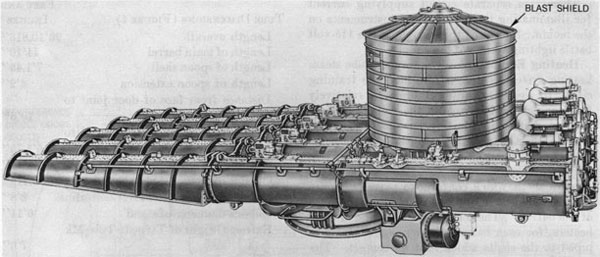
Initially 12 × 21 inch (533 mm) torpedo tubes (3 × 4) (one mount centerline). The class proved to be top-heavy and thus one quadruple torpedo mount was removed in early 1941, with the early units ships still completed with 12 torpedo tubes (three quad mounts with one mounted centerline, others on deck port and starboard). They were modified later (summer 1940, USS Sims, Hughes, Anderson, Hammann, Mustin had one bank removed). The last built were suspended and modified, then completed with two quad mounts on the centerline. They all carried the Mark 15 torpedoes. Its the torpedo change that often trigerred the removal of the N°3 5-inch gun, but was kept for some extra time most cases.
There was no longer talks of a “scissors launch” with the past destroyers, a theoretical play with modifiting the torpoedo gear setting to make them converge on a target forward. It was back to a more conventional approach.
The Mark 15 torpedo was the new WW2 standard torpedo, very similar to the Mark 14 but longer, heavier with greater range settings, larger warhead. Hoiwever, from the same NAS Newport from 1938 it also shared the same Mark 6 exploder usually causing duds. In some case, Mark 14 torpedoes even made full circles after launch, giving the chills to submarine commanders… The latter raised the alarm but it took 20 months to fix the torpedoes, during which the US kill rate was weak. When it was fixed and the new torpedoes sent to the frontline, by 1943 the situation had changed already and surface combat was rare and far between so this was not such an issue. In between, destroyers commander had taken the matter in their own hands and forcibly removed the serial exploder for an older contact one when available. The Sims class did had some occasions of torpedo fights in the Pacific, with mixed results (see later).
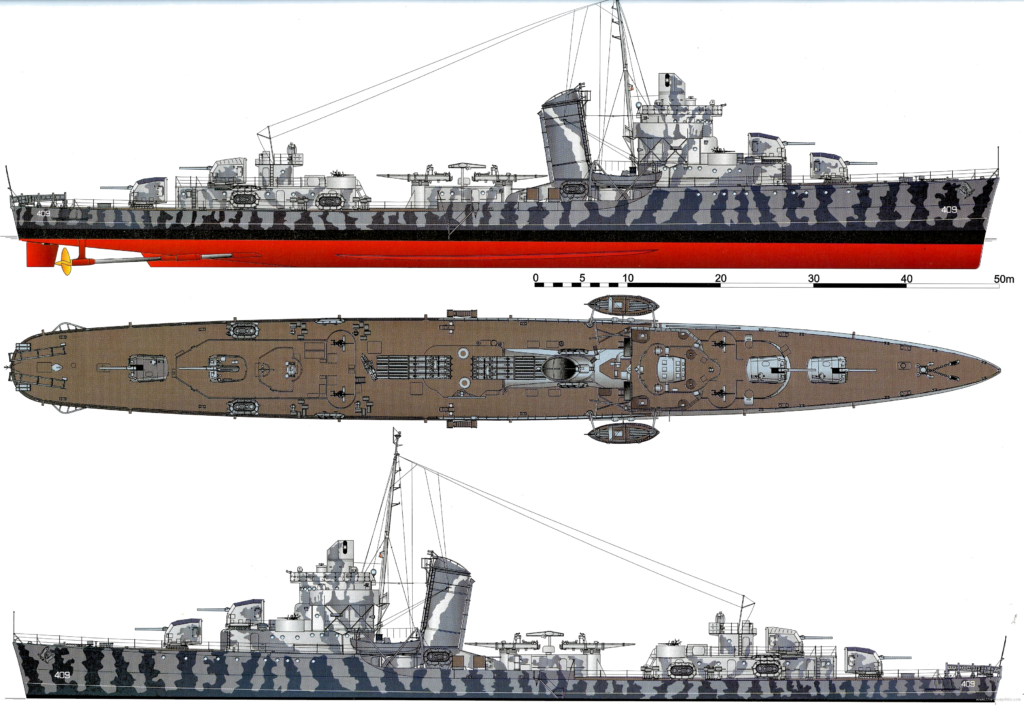
USS Sims in 1942 (src unknown – the blueprints)
Anti-Aircraft
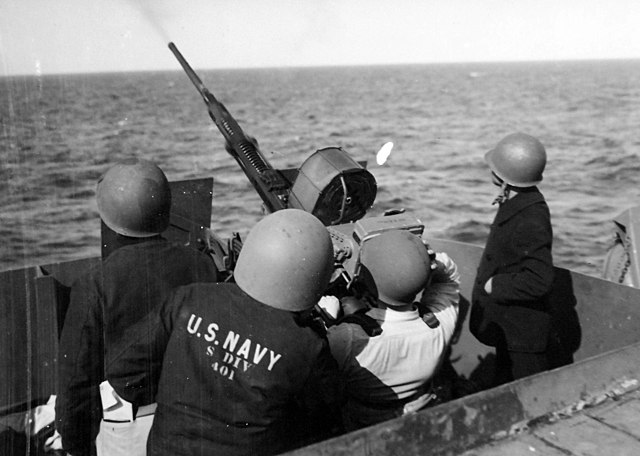
20mm Oerlikon mount on USS Hogatt Bay
Initially in 1940 this consisted only in four single .50 caliber machine guns (12.7 mm), located on the superstructre amidships. This sounds adequate at the time, but was ludicrously unsufficient in 1941 and revised. In 1941 it was decided to remove the two heavy machine guns for eight autocannons, a mix of 40 mm Bofors and 20 mm Oerlikon guns. Thus upgrade was done over 18 months after Pearl Harbor, so still oinging in 1943. Four 40 mm in two twin mounts, four single 20 mm guns seems to be the favourite configuration. The twin mounts were located in place of the N°3 DP gun. In 1945, the kamikaze threat saw for USS Mustin, Morris, and Russell the full removal of their torpedo tubes for four additional 40 mm guns, eight in four twin mounts while the single were replaced by twin 20 mm, however not or partly completed.
ASW
Initially they had just the two classic depth charge racks aft (5 DCs each), 10 total, 10 reserve. In the summer of 1941 the N°3 5-in/38 127/38 wazs removed for the addition of four extra Cal.05 Browning HMGs and one depth charge thrower (“Y”-gun), with 38 depth charges total.Tne Y-Gun was often removed in 1942 and instead four DCTs (“K”-gun) were adeed aft in place, with 58 depht charges in all. But this varied over time. By 1945, DD410, 411, 419 had in additon to their four main guns two twin 40mm/60 Mk 1 Bofors, four single 20mm/70 Mk 10, two quad 533 TT, four DCT, and two DCR with the same 59 grenades.
Fire Control and Sensors
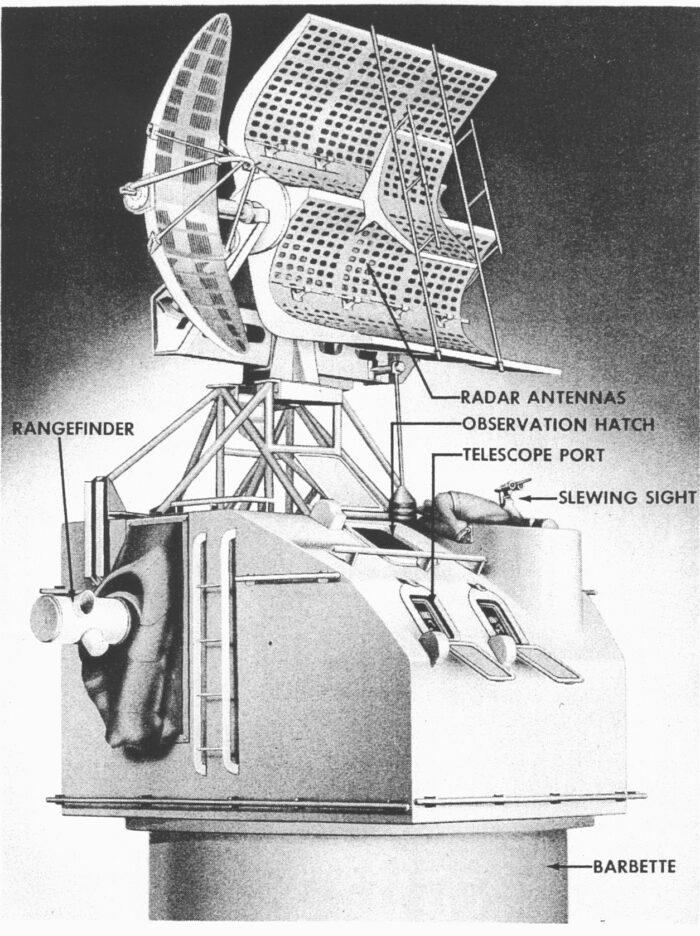
Shortly after the start of the war, they received the new Mk 37 fire control system assisted by a ballistic computer installed in a dedicated room of the bridge. A Mk 12.22 radar was installed atop.
The Sims class started the war without radars. However from 1942 to 1944 when possible they were fitted with the SC, SG, Mk 4 or Mk 12.22 radars. One was for aerial warning (SC, SG) the others for the fire control.
The Sims class were also among the last to receive the new QCE sonar instead of hydrophones, in 1945.
In many ways, the Sims were the draft of the next wartime Clemson/Gleaves. They gave full satisfaction during the war although four were lost in action: USS Sims, Hamann and O’Brien, Walke in 1942, and USS Buck in 1943. Ultimately they cumulated 91 battles stars.
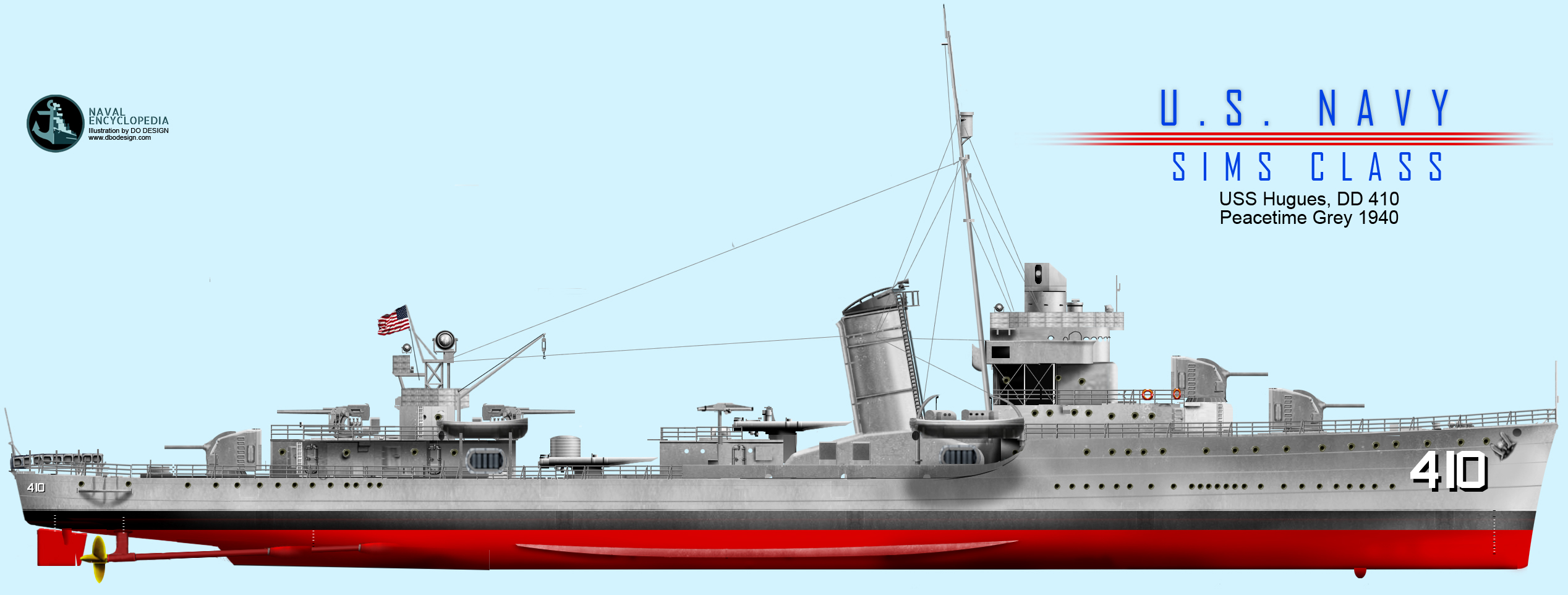
USS Hugues, DD-410 as completed in 1940

USS Mustin DD-413 in June 1942, measure 12.
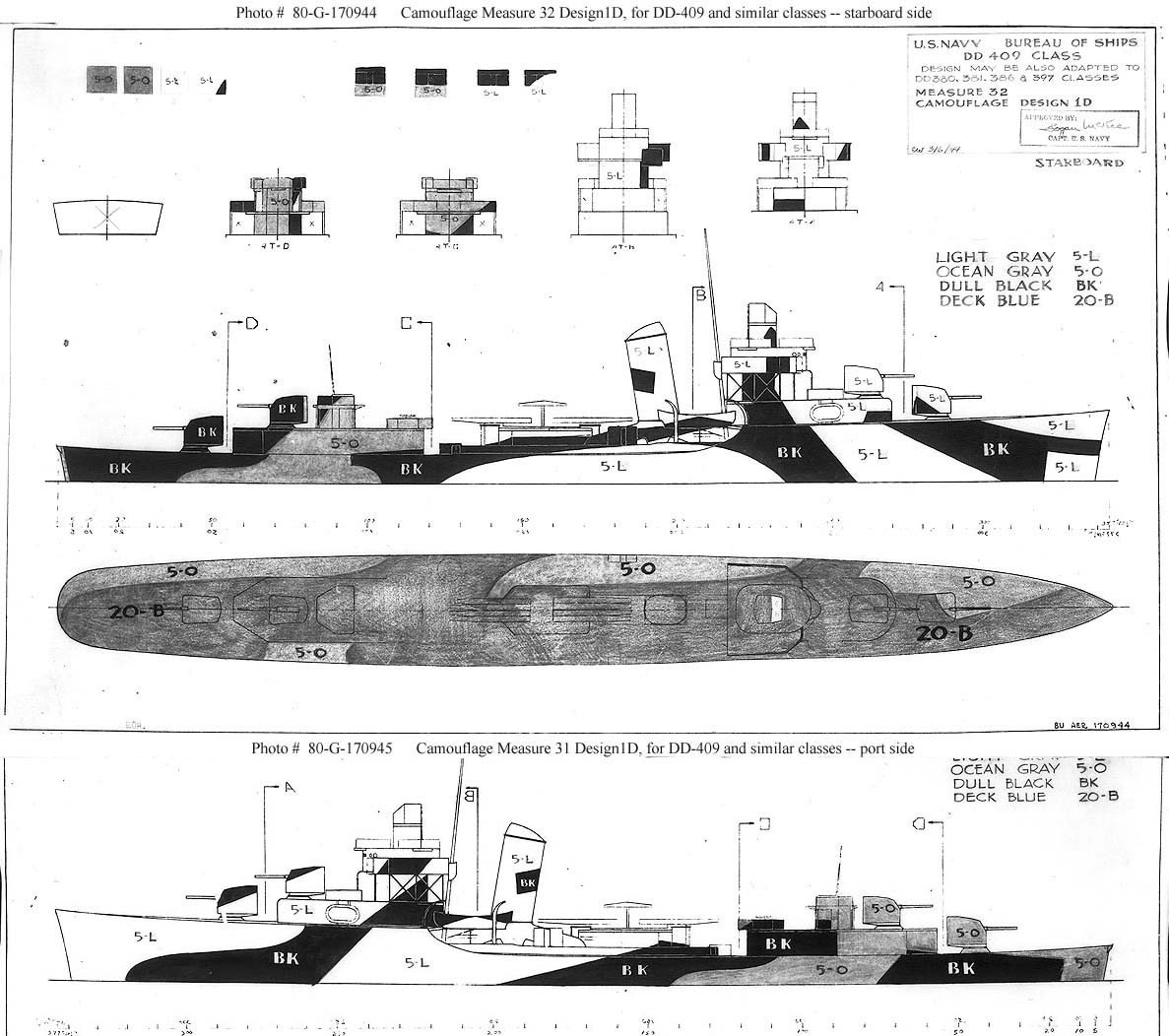
MS32 design 1D for the Sims class
⚙ Sims specifications (*modified 1941) |
|
| Displacement | 1,570 tons standard, 2,293 tons full load |
| Dimensions | 348 ft 3 in x 36 ft 1 in x 13 ft 4 in (106.15 x 11 x 4.06 m) |
| Propulsion | 2 shafts Westinghouse GST, 3 Babcock & Wilcox boilers 51,138 shp (38,134 kW) |
| Speed | 37 knots (69 km/h; 43 mph) on trials |
| Range | 444 tons oil, 5,640 nmi (10,450 km; 6,490 mi) at 12 knots |
| Armament* | 4x 5 in, 8×0.5 cal. HMG, 2x 21 in Mk15 TTs, 2 DCT |
| Sensors (1942-45) | Mk37 GFCS, SC radar, see notes |
| Crew | 10 officers + 182 ratings peacetime, 16+235 wartime |
Read More
Books
Bauer, K. Jack; Roberts, Stephen S. (1991). Register of Ships of the U.S. Navy, 1775-1990. Greenwood Press.
Friedman, Norman (2004). US Destroyers: An Illustrated Design History (Revised ed.). NIP
Gardiner, Robert; Chesneau, Roger (1980). Conway’s All the World’s Fighting Ships 1922-1946.
Silverstone, Paul H. (1965). U.S. Warships of World War II. London: Ian Allan.
Zajkowski, Edward J.; Wright, Christopher C. (June 2021). “Question 4/58”. Warship International.
Links
sims_GIBook.pdf
GENE SLOVER’S US NAVY FIRE CONTROL PAGES NAVAL ORDNANCE AND GUNNERY VOLUME 2, FIRE CONTROL CHAPTER 25 LINEAR-RATE ANTIAIRCRAFT FIRE CONTROL SYSTEMS
shipcamouflage.com sims_class
navweaps.com 5-38_mk12.php
history.navy.mil/ USS RUSSELL (DD-414)-left, and USS SIMS (DD-409)-right
destroyerhistory.org/ simsclass/
navypedia.org sims class
en.wikipedia.org/
destroyers.org/ dd-411/
on destroyersonline.com/
3D
Gallery – wow renditions
Model Kits

Blue ridge model 1/192.
Also USS Russell DD-414 1943 Iron Shipwrights 1:350, USS Walke Late 1942-43 Imperial Hobby Productions (IHP) 1:700, USS Sims DD-409 Naval Works 1:700, USS Hughes DD-410 1942 Niko Model 1:700. General query on scalemates
modelwarships.com sims class
The Sims class destroyers in service
 USS Sims (DD 409)
USS Sims (DD 409)
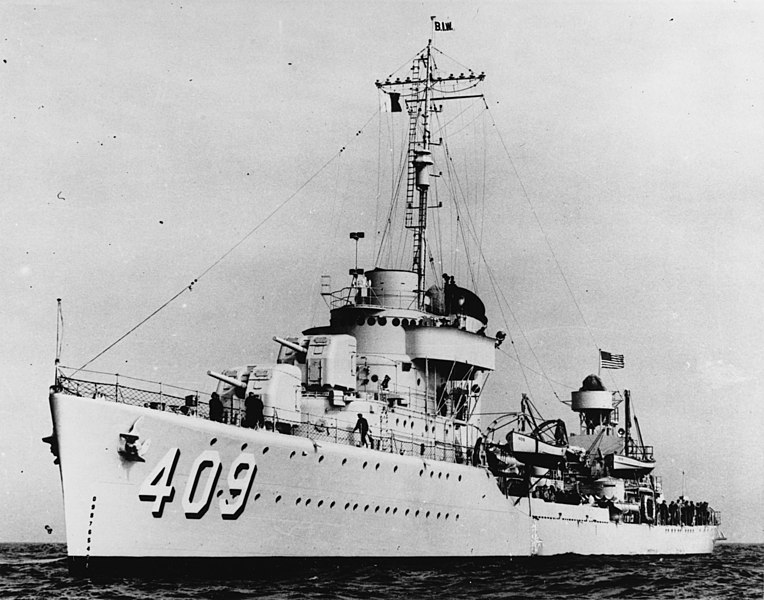
USS Sims was commissioned on 1 August 1939. After shakedown in the Caribbean, post-shakedown at Boston she joined the Atlantic Squadron at Norfolk from August 1940. Neutrality Patrol, Caribbean and South Atlantic. From December 1940 she patrolled Vichy French Martinique. On 28 May 1941 she was homeported to Newport; Iceland (28 July) and its approaches. In September–October, North Atlantic patrols, DesRon 2.
From December 1941, TF17, USS Yorktown. Sortied from Norfolk on 16 December 1941 for San Diego, escorted Marines to Samoa January 1942. Planned striked on Mili, Jaluit, and Makin. 1105 28 January enemy bomber sighted, Sims near-missed 1,500 yards astern. Later the force stroke and withdrew. Pearl Harbor, 16 February to Wake Island, changed to Canton Island. March Lexington and Yorktown attacked New Guinea, Sims remained near Rossel Island (Louisiade Archipelago) as backup. Next she took part in the Battle of the Coral Sea. She escorted USS Neosho to resupply Lexington and Yorktown, refualling on 5–6 May. 7 May, 0930, she was attacked by 15 high level bombers (missed) then 10, evaded all. Third, 36 “Vals“: Neosho was crippled. Sims was hit by three 250-kg bombs notably in the engine room (2). She buckled amidships sank stern first, and while doing so was wreched by a tremendous explosion. There were 15 remained with those of Neosho until rescued by USS Henley on 11 May. Stricken 24 June 1942. 2 battle stars.
 USS Hugues (DD 410)
USS Hugues (DD 410)

USS Hugues was commissioned at Boston Navy Yard on 21 September 1939 (LtCdr Donald J. Ramsey). After shakedown in the Gulf of Mexico, she joined the Atlantic Fleet. From July 1940 to December 1941 she patrolled off Martinique, east coast Neutrality patrol and Iceland. She was the first US destroyer escorting British convoy to England.
After Pearl Harbor she was urged to the Pacific from Norfolk by 18 December to San Diego with USS Yorktown. On 12 January 1942 she escorted a convoy to Samoa. She joined TF Yorktown for strikes on Jaluit, Makin, Mili, Canton and the combined TF17 on Lae and Salamaua (10 March 1942) but missed the Battle of the Coral Sea.
Battle of Midway: She was a screen for USS Yorktown, shooting down two B5N “Kate” and assisted 2 more, but assisted the carrier ater being hit on 4 June until torpedoed by by a sub on 6 June, depht-charging the attacker, rescuing survivors on the 7th.
She was used afterwards as convoy escort up to Guadalcanal, screening USS Hornet throughout the campaign. At the Battle of Santa Cruz destroyed a plane and assisted 2 more. Hornet was hit and sunk on 27 October. TF 16 from 10 November, Naval Battle of Guadalcanal with USS Enterprise and continuation compaign until February 1943.
Refit home, convoy to Pearl Harbor. 18 April dept. for the Aleutian Islands, Kiska operation (6–22 July). OVL 25 August in San Francisco. Pearl Harbor 26 October, took part in the invasion of the Gilbert Islands, 10 November, Makin Atoll. Escorted USS Liscome Bay. When sunk on 24 November, rescued 152. Back Pearl Harbor 7 December 1943. 13 January 1944 joined TF 53, Marshall Islands, preinvasion 3–11 February. Screened escort carriers against Palaus, 31 March. Invasion of Hollandia (New Guinea) 23 April, screen for escort carrier group: Aitape, Tanahmerah Bay. Fire-support ship until 25 September. Invasion of the Philippines: Biak, Noemfoor, Cape Sensapor, Morotai, flagship RADM M. Fechteler (not Fletcher !).
Invasion of Leyte: Flagship RADM Dewey Struble for landings on Dinigat and Homohon, entrance to Leyte Gulf. Convoys to and from New Guinea until 6 December 1944. Invasion of Ormoc Bay, Leyte. Picket destroyer south of Leyte when hit by a G4M kamikaze, 10 December 1944. 23 dead, badly damaged (one engine room destroyed, rest unoperable). Towed to San Pedro Bay for temporary repairs, then Humboldt Bay and Pearl Harbor, San Francisco, on 2 February, 3 months extensive overhaul.
Sent to Adak Island (Aleutians) 4 June 1945, Northern Pacific Force to harassing enemy shipping and shell bases untl V-Day. Patrol force, Northern Honshū until 20 October. Back home with DesRon 2, decom. 28 August 1946, target ship Operation Crossroads, sunk off Kwajalein 16 October 1948. 14 battle stars.
 USS Anderson (DD 411)
USS Anderson (DD 411)

USS Anderson was the firts hip completed in the class. She was commissioned on 19 May 1939 under command of LtCdr William M. Hobby, Jr., found to be 150 tons overweight, top-heavy forcing a redesign and rebuilding of the class in 1941. She left NY Yard in June, HP Newport on 7 July; She headed to Washington, D.C. Washington Navy Yard on 10 July to be inspected by Admiral Harold R. Stark CNO, Captain H. T. Markland, RADM Robert L. Ghormley (War Plans Director) and Ordnance Bureay chief William R. Furlong plus secretary Charles Edison. Sent to Yorktown, Virginia and Norfolk, Wilmington, then back to NOB Norfolk on 19 July to be fully equipped, embarked her marines company, and started her shakedown cruise to Guantanamo, San Juan, Panama Canal Zone, Bermuda and St. John’s in Newfoundland-Labrador by late August, visited Montreal and Quebec in September, then back to HP Newport. Weapons tests followed, then final acceptance trials off Rockland in Maine (7 February 1940 with RADM H. L. Brinser (Board of Inspection and Survey) aboard. New York Navy Yard until March, exercises to Guantanamo Bay with USS Manley. Toured west coast of Central America. Plane guard for USS Yorktown off North Island. Joined DesDiv 3 to San Diego and deparrted with USS Enteprise escorted by Hammann, Mustin, Sterett, Hopkins and Rowan to Hawaii, Pearl Harbor. Trained 5 months there. Dec. 1940 returned to the West Coast with DesRon 8.
OVL San Pedro, Los Angeles, joined Enterprise and Lexington for drills off Hawaiian Islands. Various exercises out of Pearl Harbor in Feb. March 1941. New OVL Mare Island, post-repair trials in May. Long Beach and back to Hawaii. Ordered to Philadelphia via Panama, Atlantic Fleet in June 1940 for Neutrality Patrols, central Atlantic west to Cape Verde Islands until June 1941. Plane guard for USS Wasp, Bermuda in July 1941. HP Norfolk, mods Boston. Post trials Casco Bay, Maine in 2 September with USS Tuscaloosa. Assigned TF 15 to Iceland, landings. Reykjavík 15 and to Placentia Bay, Newfoundland.
ASW screen TF 14 (Yorktown) off Maine, 13 October. Versed to TG 14.3 (USS Savannah, Philadelphia, New Mexico, Yorktown) with seven destroyers, escorting six British cargo ships to UK. 30 Octobe made underwater contact, dropped six DCs, probable kill. Hvalfjörður on 7 November. Left Icelandic waters with USS Idaho and Mississippi to Denmark Strait 6 December 1941.
Recalled to Pearl Harbor, via Norfolk, Charleston, with Hammann, Mustin, Morris, OVL Charleston, Norfolk 5 January 1942, escorted USS Mississippi BatDiv 3 to Panama. San Diego, trained and joined Convoy 2019 to Hawaii, arrived 2 February. Joined TF17 (Yorktown) escorted by USS Astoria, Louisville (RADM FJ. Fletcher) to the southwest Pacific. 6 March 1942 joined TF 11 to attack Rabaul.
Next: New Guinea. After patrols, joined New Caledonia. Under RADM John G. Grace, RN for escort. Joined TF 11 14 March for Lae-Salamaua raid.
Next: Solomon Islands with USS Yorktown: Battle of the Coral Sea. Assigned 7 May to TG 17.5 (USS Lexington). Attack on 8 May, Anderson maintained station on Lexington, no hits. Later assisted crippled “Lady Lex” on 10 May, rescued 377. To New Caledonia, then TF 17 to Pearl Harbor.
Battle of Midway: Escorted TF 17’s Yorktown. USS Anderson claimed 2 “Val” and later one “Kate”. Assisted Yorktown until sunk by I-168.
Next, escorted USS Long Island to Palmyra and Pearl Harbor.
Guadalcanal Campaign: TF 17 to the Solomons then TF 61 (29 August) and TG 61.2, USS Hornet. Battle of the Eastern Solomons 24 August. Screened Hornet when attacked by sub I-19 northeast of USS Wasp. Back to Tongatapu on 19 September. Escorted Dutch convoy to New Caledonia. TF 17 raid on Buin-Faisi.
Battle of the Santa Cruz Islands: TF 17 with USS Hornet, TF 16 (TF 61). 26 October, tried to defend Hornet. claimed damaged 2 planes, splashing 1, then another torpedo plane, and damaged several others, light damage. Picked up 247 from Hornet. Finished off with Mustin with shells and four torpedoes.
More ops off Guadalcanal until end of the 1942.
Until 23 January 1943 joined TF 16, Espiritu Santo, escorted TU 62.4.7 to Guadalcanal. Made photographic reconnaissance and bombardment on Guadalcanal 29 January with Wilson.
New Hebrides hunter-killer missions, TF 67-TF 68 until 7 March 1943. Pearl Harbor, OVL San Francisco. Back July 1944 with TG 96.1 to Kodiak, then TG 16.17, bombardments of Kiska. Dept. 21 September for Pearl Harbor. New Zealand for escort, then TF 53 to Tarawa in November, Fire Support Group No3 on Betio 20 November.
Battle of Kwajalein: Escorted 4th Marine Division, diversionary strike at Wotje 30 January 1944. Took a hit in in CIC, killed all. XO took command. Roi-Namur next. Later struck uncharted pinnacle. Towed to Pearl Harbor, repaired. Sent to New Guinea with TG 77.3.
Battle of Leyte Gulf: Dept. 12 October with TG 78.2, Leyte Gulf 20 October. Joined TG 77.2 25 October. Scored hits on several air attackers, splashing one. A Nakajima Ki-43 “Oscar” crashed into the her port side (16 dead, 20 wounded). Back Pearl Harbor 29 November 1944, repaired San Francisco until April 1945.
Back Attu 11 May 1945 with TG 92.2. Bombardment of Suribachi Wan, and raid Sea of Okhotsk. Bombarded Kuril Islands. Patrol east of the Kurils until 12 August 1945.
Headed for Japan 27 August, Ominato, occupation of northern Honshū. Back San Diego 1 December, spent in Operation Crossroads, Bikini lagoon. Stricken 25 September 1946. 10 Battle Stars.
 USS Hamman (DD 412)
USS Hamman (DD 412)
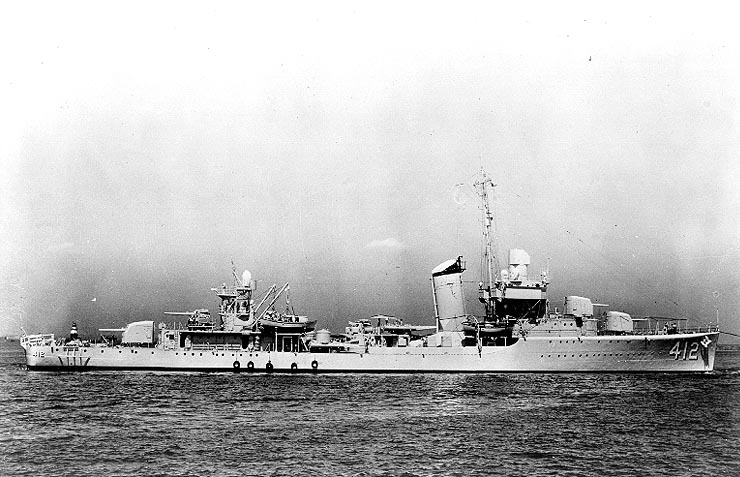
Commissioned on 11 August 1939 (Arnold E. True) USS Hammann made her shakedown off the East Coast and spent the enewt two years training on both coasts.
On 10 June 1939, she voided collision with USS Warrington with King George VI and Queen Elizabeth aboard (royal tour of the United States). It was claimed she reached a maximum speed of 40 knots durng a demonstration, then had her turbines in full reverse, stopping in 58 seconds, and then sailed in reverse at 20 knots.
By December 1941, she was par tof the North Atlantic Patrol off Reykjavík. She ws in Norfolk on 17 December to resupply and left for Charleston, met USS New Mexico and SS President Hayes to Panama Canal and San Diego, then San Francisco. On 22 January 1942 she was in Pearl Harbor, joined TF 17.
After training maneuvers off New Caledonia in March 1942 she sails for the Coral Sea, screening USS Lexington until back to Tongatapu on 20 April. She took part on the 27 April air raid on Tulagi.
On 4 May, USS Hammann rescued two fighter pilots downed on Guadalcanal and returned to Lexington.
A the Battle of the Coral Sea she screened the carriers and downed at least two Japanese torpedo planes and tried later on dive bombers appeared. She had a near miss, 200 yards of her starboard bow. Lexington was later crippled and she assisted her with USS Anderson, rescuing 500 men on 8 May.
She was also present at the Battle of Midway, her last. On 30 May after a short run to Pearl Harbor she was back in escort on 4 June of USS Yorktown, and assisted many kills. She picked up survivors of Yorktow including Captain Buckmaster. The carrier was still afloat and repaired on 6 June until sunk by I-168. Of the spread, one on the fourth hit Hamman amidships, breaking her in half. She sank, bow first in four minutes, followed by a violent underwater explosion and she lost 80. Survivors were picked by Benham and Balch. Commander Arnold True was later awarded the Navy Cross, Navy Distinguished Service Medal and the ship two battle stars.
 USS Mustin (DD 413)
USS Mustin (DD 413)
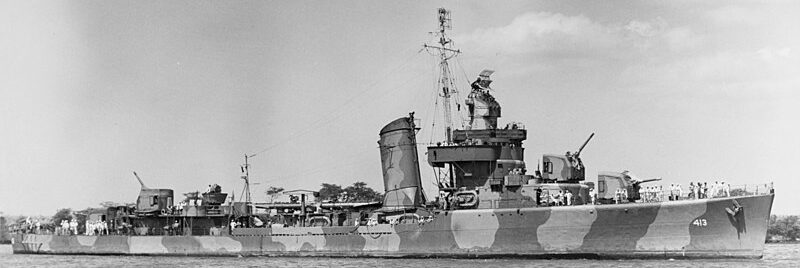
USS after commission and shakedown, then basic training, gunnery training, joined the Atlantic Fleet and a neutrality patrol time in the western Atlantic. By December 1941 she was being overhauled at Boston Navy Yard, which was rushed over to sail out the following day to escorting USS Idaho and Mississippi and completed this overhaul in Charleston on 3 January 1942. Then she crossed on orders the Panama Canal on the 20th reaching Pearl Harbor on 17 February and started escorting convoys between Hawaii and San Francisco, until 3 April, then to and from Samoa on 24 May. Later for reinforcements to Midway and she was back on 5 June to depart after with TF 17 looking after survivors of the battle of Midway. Next she started 2 months of training and patrols and returned with TF 17 on 17 August (USS Hornet group) to Guadalcanal as she launched strikes on Buin, Faisi, and Tonolai. Next she was present at the Battle of the Santa Cruz Islands on 26 October, rescued 337 survivors of the carrier and finishing the hull withtorpedoes. She claimed however five enemy aircraft in defense of her.
Next followed a period of convoys Nouméa-Espiritu Santo. By 11 November she joined TF 16 and took part in the Naval Battle of Guadalcanal. On 25 December she shelled positions on Guadalcanal. By February 1943 she did the same, then escorts until 14 April 1943 and back to Pearl Harbor.
Next she was sent to take part in the Aleutian Campaigns, first at Adak, then Attu and shelling Kiska. After occupation of Kiska on 15 August, she headed for an OVL at Mare Island Naval, and back to Pearl Harbor on 31 October 1943.
Next she fought in the Central Pacific until October 1944 (assault on Makin, Marshall Campaign (Wotje, Kwajalein, Eniwetok) and back to Pearl Harbor on 3 March 1944.
Escorting part of TF 58 (their fleet oilers) she assisted to strikes on Palau, Yap, Woleai, Ulithi (Carolines). In April she screened carriers during the assault on New Guinea (Aitape, Hollandia, Wakde) and rampaged IJN positions from Noemfoor to Biak.
Next was the Philippines campaing from October 1944 to February 1945. The assault on Morotai, and invasion of Leyte. She took part as an escort in the Battle for Leyte Gulf in distant support but splashed 3 planes on 27 November. Next was the assault on Luzon on 9 January 1945, repelling other attacks off Lingayen.
In the end, she was prepared for the Okinawa campaign in March–May 1945. This started off Hagushi Beach on 1 April, guarding transports and later one from Saipan and Ulithi. She also became a radar picket until 2 May leaving on 28 May for Guam, made a convoy to Pearl Harbor to Eniwetok and San Pedro (18 June) for an OVL, learning about the end of the war. She was present off Ominato, Honshū by 16 September and back home, ended soon in Operation Crossroads, later destroyed by gunfire on 18 April 1948 in the Marshalls. She won 13 battle stars.
 USS Russel (DD 414)
USS Russel (DD 414)

USS Russel was Commissioned just two months after the start of WW2, training in the western Atlantic-Caribbean and soon thrown into neutrality patrols until the attack on Pearl Harbor.
Via Panama Canal she reached San Diego and departed for Samoa on 6 January 1942. On the 25th like most of her sister she operated with TF 17, USS Yorktown during the raids on Makin, Mili, and Jaluit and in another sotie, Wake Island, and covering Canton Island operations. Newt were Raids on Rabaul and Gasmata. She later joined Lexington force to Papua on 10 March, rampaging Huon Gulf.
She returned to USS Yorktown in ANZAC area. Later she escorted USS Neosho with TF 11, and was back with TF 17, taking part in the Battle of the Coral Sea, defending Yorktown and Lexington and later assisted the latter.
She landed the 170 recued men to Tonga, and returned to Pearl Harbor. Then she took part in the Battle of Midway with TFs 16-17, as screening Yorktown until she was sunk, rescuing 492, later transferred to USS Astoria and clearing the area for Pearl Harbor. After 2 months training she returned with TF 17 in August with USS Hornet, later TF 61, and TG 61.2 and the campaign for Guadalcanal. On 6 September one plane from Hornet dropped a bomb on Russell’s starboard quarter to detonate an incoming torpedo, which save her. At 1452 that day she made contact and depht charged the bogey until having an oil slick. Probable kill.
On 25–26 October she took part in the Battle of the Santa Cruz Islands, assisting the crippled Hornet. She hosted TF 17 commander, RADM George D. Murray and staff, then carried to USS Pensacola and other personal to USS Northampton, the remainder to Nouméa. Russell had her superstructure damage repaired there.
Until January 1943 she escorted convoys to Guadalcanal, Tulagi, Rennell and screened USS Enterprise, also to Australia and back. She had an OVL at Mare Island and returned in July 1944, sent north for the invasion of Kiska. From Hawaii by October she made it to Wellington, then to the New Hebrides and TF 53 for the Gilberts Campaign. She escorted ships to Tarawa. She joined later TG 50.3 and to the Marshall Islands and back to Pearl Harbor
She departed the Calfornian coast with TG 53.5 for Wotje and later Kwajalein. She had another OVL in Puget Sound until March 1944. She sailed to New Guinea with DesRon 2 and TF 76, staying for the New Guinea campaign and TF 77 (Wakde, Biak, Padaido Islands, Toem area) and rested at Manus Island. She took part in Operation Globetrotter (Sansapor) and occupation of the Molucca Islands then Morotai.
On 13 October she operated with TF 78 to the Philippines, Tacloban and Alabat Point. Later she was in Leyte Gulf and New Guinea. She took part in the invasion of Luzon, and sank IJN Hinoki from Manila. In Janruary she was in Lingayen Gulf and escorted convoys to Leyte, New Guinea, and the Solomons. She later took part in Operation Iceberg on Okinawa, patrolled off Ie Shima and Kerama Retto, stopped at Hagushi anchorage before going home and her last OVL at Seattle until V-Day. She was sold for scrap in 1947. She earned 16 battle stars, the most decorated of her class.
 USS O’Brien (DD 415)
USS O’Brien (DD 415)

After commissioning, shakedown and training, USS O’Brien started neutrality patrols off the Eastern Seaboard. She was in drydock at the fall of 1941 in Norfolk, departing on 15 January 1942 with USS Idaho and her sister Mustin for the Pacific Ocean, crossing the Panama Canal on 20 January to San Francisco and headed idrectly for the Western Pacific on 4 February 1942 until a collision with USS Case. After repairs at Mare Island she went for Pearl Harbor hosting the Commander of DesDiv 4 from 5 March 1942. She went to Midway escorting the seaplane tender Curtiss and later NAS Palmyra Atoll and convoys from San Diego- San Francisco to Samoa in late April.
On 26 May she assisted the US occupation of Wallis Island (from the Free French) and joined the auxiliary ship Procyon back to Pearl Harbor. Escort duties went on, notably with TF 17 to Guadalcanal. She drove the submarine I-19 on 15 September 1942 after she sank USS Wasp and damaged USS North Carolina. But also USS O’Brien which from six torpedoes took one, to her port bow.
But she survived it and sailed for repairs at Espiritu Santo, and USS Curtiss. Next she sailed to Noumea for new repaired with USS Argonne and plan to complete this at San Francisco, but the damage proved greater than expected and she slowly flooded, reaching instead Suva, Fiji on 13 October 1942 until she was forced to reach the nearest anchorage, her captain trying to make it to Pago Pago. On 19 October structural damage was such that she sank after orderly evacuation. She made 3,000 nautical miles (5,600 km) after her torpedoing and had all crew members alive, which was extremely rare. She won one battle star.
 USS Walke (DD 416)
USS Walke (DD 416)

USS Walke was commissioned on 27 April 1940. After trials, shakedown and preparations in Norfolk on 27 June 1939, she embarked 47 enlisted marines to USS Wichita, and proceeded for her shakedown with her sister Wainwright to Cuba. She also visited Rio de Janeiro, Rio Grande do Sul, Buenos Aires, Santos and Bahia, and met USS Quincy and Wichita on 15 August. Long story short she was fueling at San Juan on 6 December 1939, starting her Caribbean Patrol with O’Brien and Desdiv 17 as flagship for one day.
She patrolled at the Guantanamo Bay and Haiti, then Puerto Rico, and Charleston in March-May 1941 for an OVL. From Newport she patrolled the Atlantic coast until June 1941 and in July escorted a convoy to Reykjavík. She was in Newfoundland by October and Maine, in Overhault at Boston in November-December 1941.
Urged to San Diego, she operated with TF17 from January 1942: American Samoa, Tutuila, escorting USS Yorktown. Ellice Islands, New Caledonia, New Guinea, New Britain, Bougainville, Louisiades and the Solomons Capmpaign. She shot at her first attackers on 7 May, “Vals” dive bombers. She went on escorting Yorktown in Fiji-Tonga but needed repairs due to a damaged starboard reduction gear, in Brisbane, returning in New Caledonia by June. She joined TG 12.1 for Bora Bora and TG 6.7 to San Francisco.
After OVL at Mare Island she missed the landings at Guadalcanal but took part in convoys to the Solomons.
She took part however in the Naval Battle of Guadalcanal with TF 64 (USS Washington and South Dakota), and on 14 November after spotting the Japanes a destroyer column formation was mde with USS Walke leading. At 00:30 Walke opened fire to starboard seemingly a cruiser with single stack and by 00:39 attempted made a torpedo attack in Curved Fire Ahead. She was straddled by gunfire. Soon a sitting duck, order was to abandon ship and she sank at 00:42 when her depth charges exploded, killing six officers and 66 enlisted. She fired circa 300 5-inch shell before being blasted by IJN cruisers that night but was also hit by a “Long Lance” torpedo. 151 men were rescued, but some ended in POW camps. 3 battle stars.
 USS Morris (DD 417)
USS Morris (DD 417)

Commissioned on 5 March 1940 under Harry B. Jarrett in command, USS Morris made her shakedown and joined DesRon 2 by the summer of 1941 after training, for the North Atlantic Patrol. HP Charleston she received the very first fire control radar on an US DD. On 3 January 1942 she sailed for Pearl Harbor and TF 17. After a run to Noumea, she took part in the Battle of the Coral Sea, guarding carriers. On 4–8 May, she splashed one plane, damaged two and rescued 500 survivors from Lexington but also received damage, repaired in Pearl Harbor. She also took part in the Battle of Midway and recued 500 from the crippled USS Yorktown.
With TF 61 latter she was in support of the Guadalcanal Campaign, touring the Solomon Islands until 25 October, and next took part in the Gilbert Islands operation and the Battle of the Santa Cruz Islands, splashing 6 aircraft that day and rescued 550 from USS Hornet. Repaired at Espiritu Santo she returned off Guadalcanal with USS Enterprise and with USS Russell.
By May 1943, she took part in the Aleutian Islands Campaign, Attu and Kiska, before a 7 month OVL in San Francisco. In November 1943 she escoted the VCLs USS Liscome Bay, Coral Sea, and Corregidor for the Gilberts Campaigns, and rescued men from the sinking USS Liscome Bay. Next this was the Marshall Islands Campaing. On 30 January 1944, she led a shore bombardment mission on Wotje and later Kwajalein then Namur. In February 1944 she joined TG 51.11 for the attack on Eniwetok and stayed on the area until back in Pearl Harbor.
Back in April 1944 she joined the 7th Fleet for the Western New Guinea landings, Hollandia, Toem-Wakde-Sarmi, Biak, Noemfoor Island, Cape Sansapor, Halmahera, Morotai and the pre-invasion of the Philippines.
On 16 October she escorted TG 8.6 to Leyte Gulf.She acted as picket ship and fought kamikaze, later escorting troops and supplies to Leyte, followed by Luzon operations or the pre-invasion bombardment and later direct fire support on 9 January 1945. Next she was sent to the 5th Fleet for the Okinawa Campaign. After Kerama Retto with TG 51.11 she escorted various ships to their sectors and on 6 April at station A-11, fired on an approiaching Nakajima B5N “Kate”, hit and afire, but at 18:15, it crashed on her portside between the her forward guns. Fires spread battled for 2 hours and she received temp. repairs at Kerama Retto, her smashed bow being loosely repaired. She deplored 13 dead, 45 wounded.
On 18 June she reached San Francisco NyD to be declared a constructive loss, decommissioned on 9 November 1945 and stricken. With 15 battle stars she was the second most decorated of her class.
 USS Roe (DD 418)
USS Roe (DD 418)

USS Roe was commissioned on 5 January 1940 (Captain LtCdr R. M. Scruggs), and after shakedown and exercises along the east coast and Pacific was founf back in the spring of 1941 on the east coast patroling the mid-Atlantic, then from Naval Station Argentia to Newfoundland and Iceland. By January 1942 she patrolled from Bermuda to Norfolk and after a stop at New York, resumed North Atlantic convoys. From Iceland she went to the Denmark Strait. Later she escorted ships to Panama followed by North Atlantic to UK and back to the Caribbean, later Trinidad and Brazil.
Her first important escort mission was for Operation Torch in North Africa, with Northern Attack Group, Mehedia, and providing gunfire support to Port Lyautey on 7/8 November using her SG radar to locate the beacon submarine. She help guided it to the transport area and acted as control destroyer, Blue and Yellow beaches. She silenced batteries at the Kasba.
She departed on 15 November for Hampton Roads. Next she was back to escorts, tanker runs to the Gulf of Mexico and Caribbean oil ports and to Casablanca. Next she took part in the Allied invasion of Sicily.
She started operations from Oran, Bizerte, with the JOSS force to Licata on 8 July. On 9 July while dodging a minefield she collided with USS Swanson with her bow damaged. Spotted by the Italians, their position was communicated to the Luftwaffe but they fired back and shot down one Junkers Ju 88, proving the worht of their new fuses in antiaircraft fighting.
She stopped at Oran then was repaired in New York and was back to routine escorts by September, with two runs to North Africa and convoys HX 155, ON 31, HX 161 and ON 43.
By the start of 1944, USS Roe was transferred to the Pacific from New York on 26 January via Panama Canal and reporting to TF 76 on 12 March. She went to and took part in the New Guinea Campaign From 16–21 March, notably on Manus Island, the landings at Humboldt Bay (22 April), offensive on Toem-Wakde and Biak. By 29 April, Driniumor River and by July, Noemfoor.
Next she was in Majuro to join the 5th Fleet as aircraft rescue ship at Maloelap, Wotje, Mili, Jaluit and took other roles during the Marshall and Mariana campaign before joining TG 94.9 to Iwo Jima.
By December she was in Saipan. Back off Iwo Jima on 24 December she sank a small trawler and a transport destroye, also shelling on many positions. She supported striked on Volcano and Bonin Islands, rested at Ulithi and escorted ships from Guam, then back to Volcano-Bonin as radar picket and SAR. In June she was sent to the west coast, San Francisco Bay on 29 July, started an overhaul when the war ended. So she was decommissioned on 30 October. 6 battle stars.
 USS Wainwright (DD 419)
USS Wainwright (DD 419)

Commissioned on 15 April 1940 and after shakedown, training, USS Wainwright started Atlantic Fleet Neutrality Patrols. She departed Halifax on 10 November with Convoy WS-12X via the Cape of Good Hope to Basra, Near East. Shr reached Cape Town on 9 December 1941, reached Suez and proceeded to Australia to reinforced Singapore, and headed back home as the war erupted for the US.
Bacl to the east coast she patrolled until mid-March 1942, the joined the British Home Fleet, escorting USS Wasp, North Carolina, Washington, Tuscaloosa, Wichita and seven other destroyers from Casco Bay. She was flagship of DesRon 8. This presence against the Kriegsmarine free forces sent to the Indian Ocean to take part in the invasion of Madagascar. Based in Scapa Flow they patrolled the western approaches and British Isles in April.
Arctic Convoys: The fall of 1942 saw USS Wainwright in convoy on the Iceland-Orkney-Mursmansk route. She exchanged fire with the Luftwaffe and spotted U-Boats. While escorting PQ 17 to Archangel she fought hard on 4 July by mid-afternoon, repulsing two torpedo-plane raids. She dodged all, but one splashed 150 yards (140 m) away. Later she was attacked by 25 Heinkel 111s. One wing dropped their torpedoes about 1,000 yards (900 m) to 1,500 yards (1,400 m) from USS Wainwright, all evaded until some hit the transports William Hooper and Azerbaidjan. Wainwright’s AA gunners damaged 3 and repelled the assault.
However at 1900, as she joined her task unit, warning was sent of a sortie of KMS Tirpitz, Admiral Scheer, and Admiral Hipper. Convoy PQ 17 scattered and Operation “Rosselsprung” was a slaughter.
Wainwright went on in escorts until fall 1942 but she took part in Operation Torch and the invasion of French Morocco with Task Group 34.1 (Massachusetts, Tuscaloosa, Wichita). As part of the Covering Force she was away to prevent a sortie by French warships from Dakar and later bt those at Casablanca.
She took part in the Naval Battle of Casablanca on 8 November damaging two Vichy French planes and shelling submarines, destroyers, and the cruiser Primauguet salling forth. She also silenced batteries ashore.
She was back on 21 November to NyC for a short refit and back to transatlantic convoys for 6 months, notably to North Africa. While in Morocco she hosted Sultan Sidi Mohammed. She tried to protect Convoy UGS-6 and trained with other ships of the Atlantic Fleet.
She also took part in the invasion of Sicily in July 1943 with TG 80.2, fighting on 26 July Junkers Ju 88s. After this she resupplied at Mers-el-Kébir in Algeria, before returning there and to Naples in support of the 5th Army.
Back to convoy escorts off Algiers one day she made contact on U-593, attacking her until she was forced to the surface to be finished off by gunfire. A boarding party was launched but the U-boat could not be saved. She arrived with POWs for interrogation to Algiers. Next she took part in the Landings at Anzio-Nettuno. She was ordered back to the US via the Azores tp New York on 12 February 1944 and an OVL.
By April 1945 she was ordered to the Pacific via Panama, San Diego, Pearl Harbor, and Ulithi on 13 June 1945 with two months of escort between Iwo Jima, Okinawa, Saipan, Guam, and Eniwetok. In August she learned about V-Day while sailing with TF 49 for the Aleutian Islands. She arrived in Adak and joined TF 92 to Honshū, Ominato Ko (12 September) and supporting the occupation forces until 30 October, a returned home, San Diego (16 December) but designated for the Bikini Atoll blasts tests, survived, decom. on 29 August 1946, sunk as target at sea on July 1948. 7 battle stars.
 USS Buck (DD 420)
USS Buck (DD 420)

Like Roe, Buck mostly served on the European theater. Commissioned on 15 May 1940 she made her shakedown training, and was assigned to the Atlantic Fleet with a short sweep to the Pacific Fleet from February until June 1941. On 1 July she was back in the Atlantic, assigned to TF 19 at NS Argentia in Newfoundland escorting the convo carrying the 1st Provisional Marine Brigade to Reykjavík, for the occupation of Iceland. She went on escorting ships between Iceland and the United States.
She went on between Newfoundland, Iceland, Northern Ireland, but also North Africa and the Caribbean. On 22 August 1942 in heavy fog she was rammed starboard by the New Zealand troop-transport Awatea, broke her keel up to the fantail, lossing 7 sailors. She lost her starboard propeller, had her port propeller damaged and the crew tried to repair her on the march. The port propeller fell off later and her fantail was cut loose. As Ingraham came to assist, she colloded with the oiler Chemung and sank. In fact the crippled Buck recscued men from Ingraham. The oiler took Buck under tow, until the tug Cherokee took relay until Boston on 26 August with repairs until November.
Back to Atlantic convoyd into June 1943, she was sent to North Africa for patrols. She took part in Operation Husky. On 3 August from Sicily to Algeria she spotted the Italian submarine Argento surfaced, chased her, depht charged her to force her to surface and sunk her with gunfire, taking aboard 45 of her crew as POWs.
Next in September she took aprt in Operation Avalanche (Salerno). On 9 October after midnight she was caught by U-616 (Kpt Siegfried Koitschka) and hit forward starboard by at least one and possibly two torpedoes, flooded quickly, and sinking in four minutes. Like most destroyers of her class, her depht charges set loose detonated, aggravating the losses underwater explosion. 97 survivors were rescued by USS Gleaves and British LCT-170. 3 battle stars.

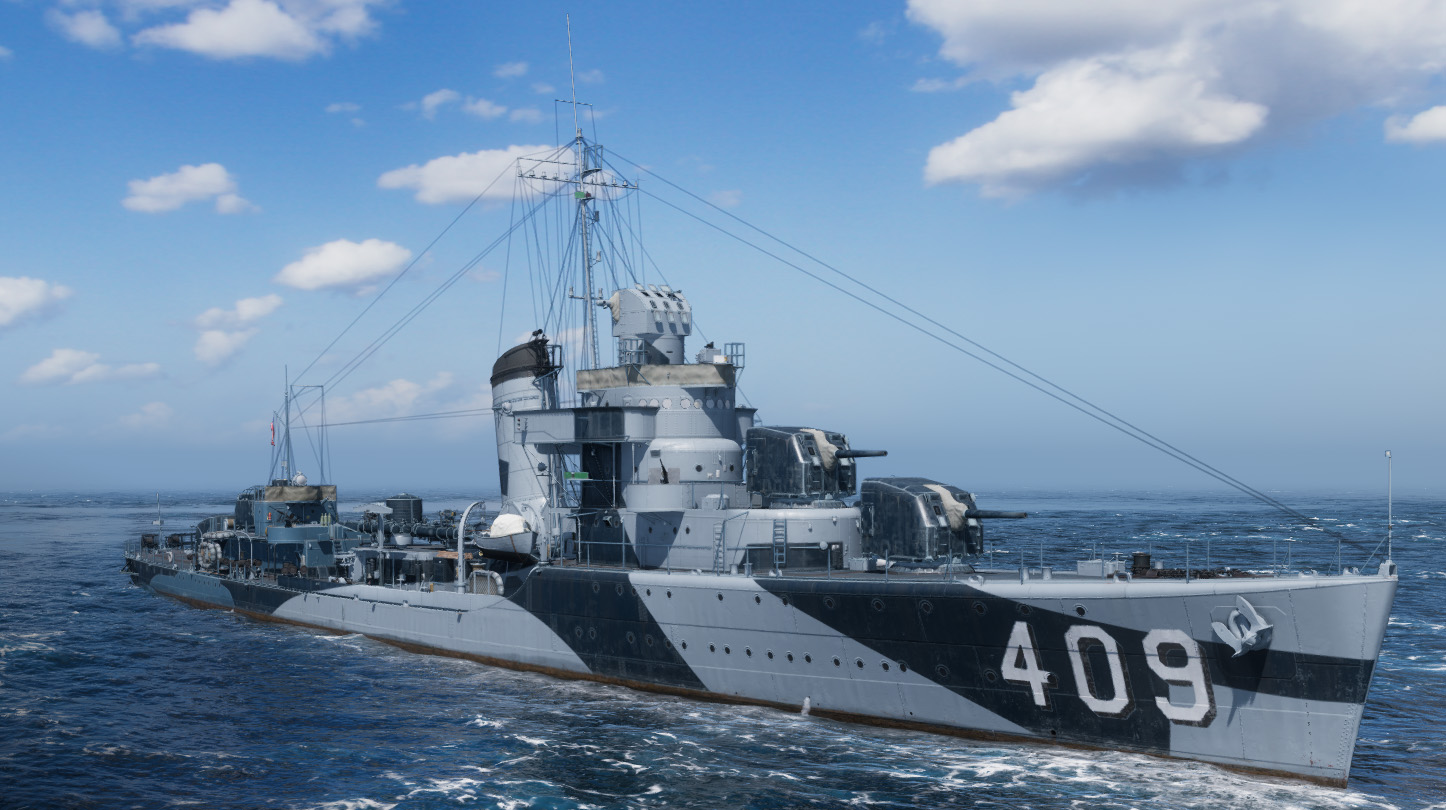
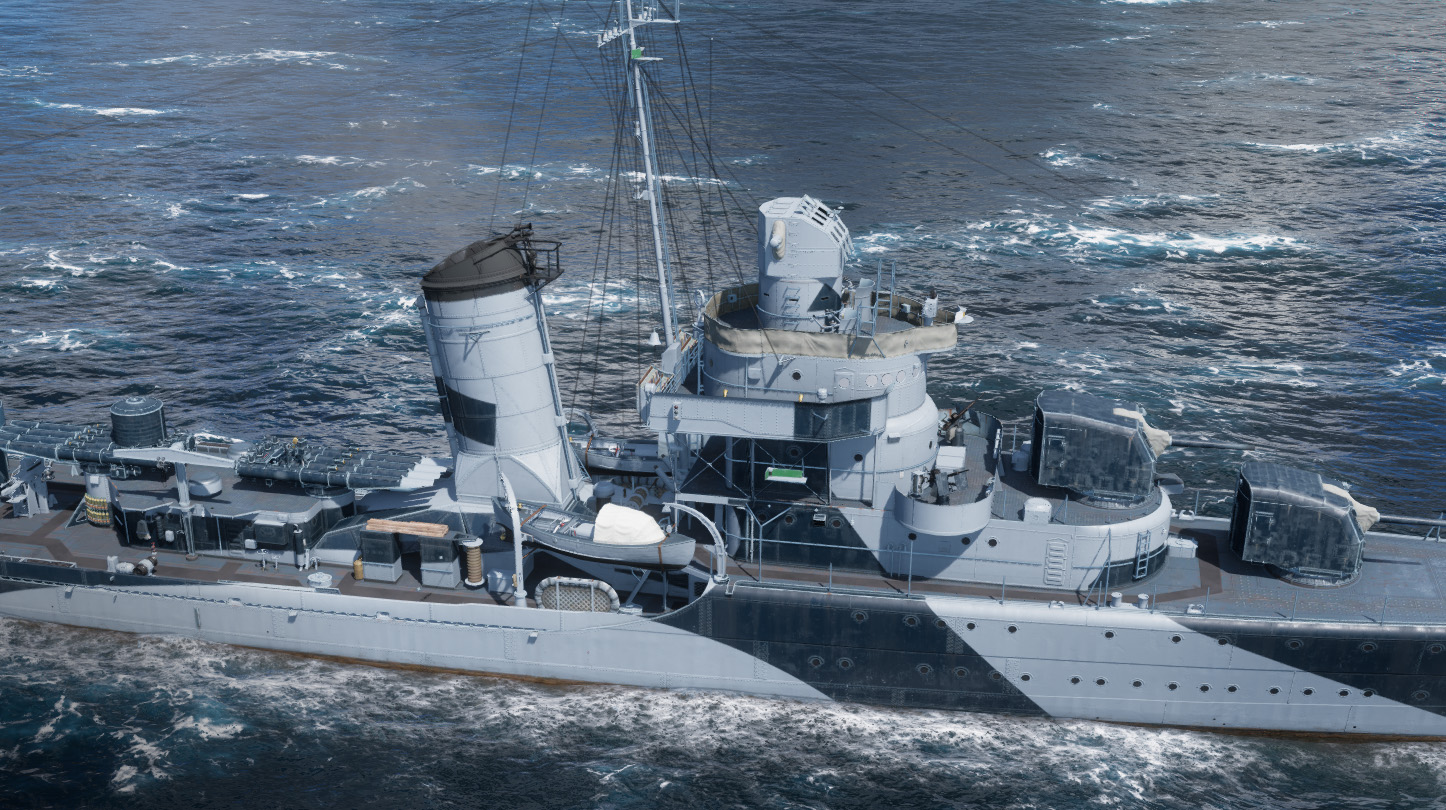
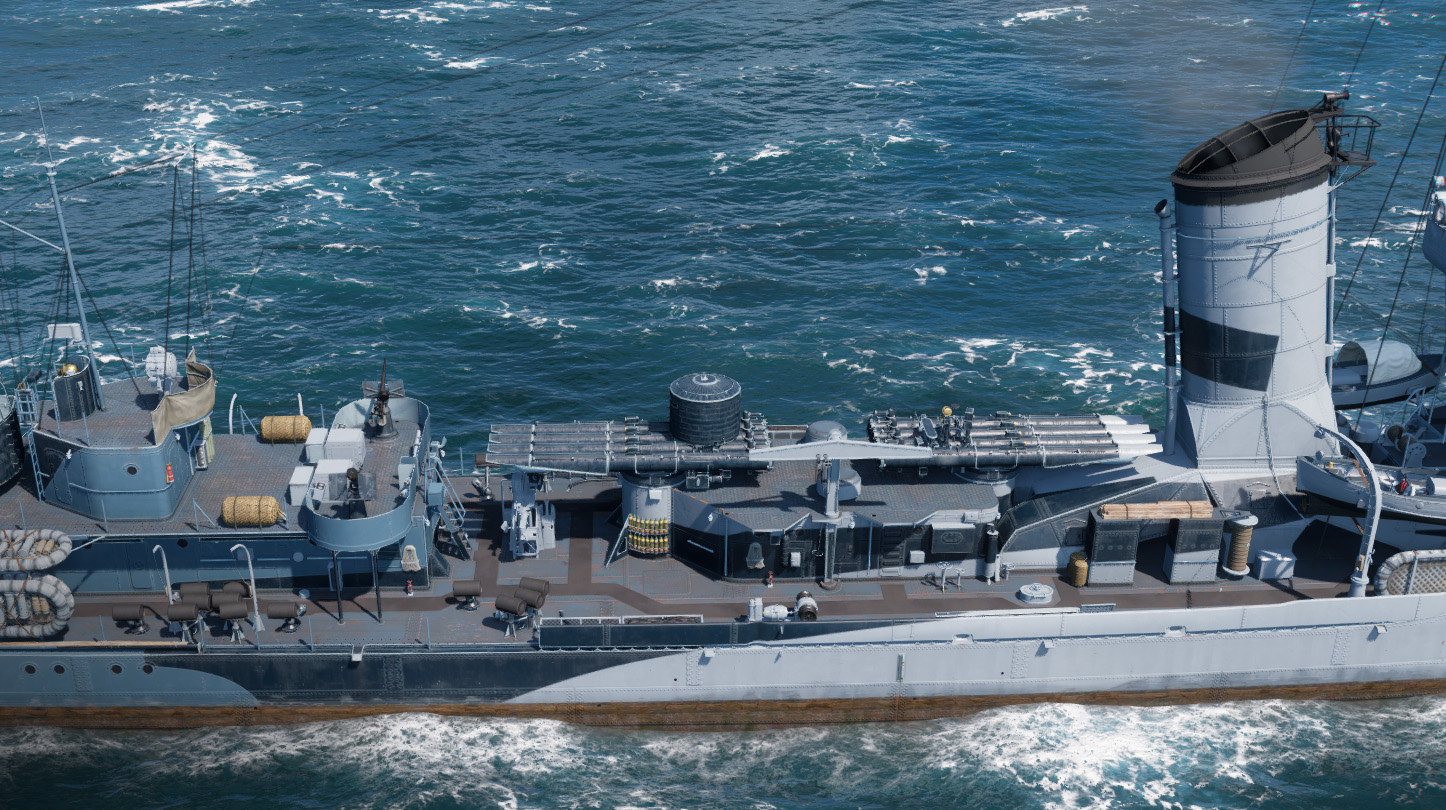
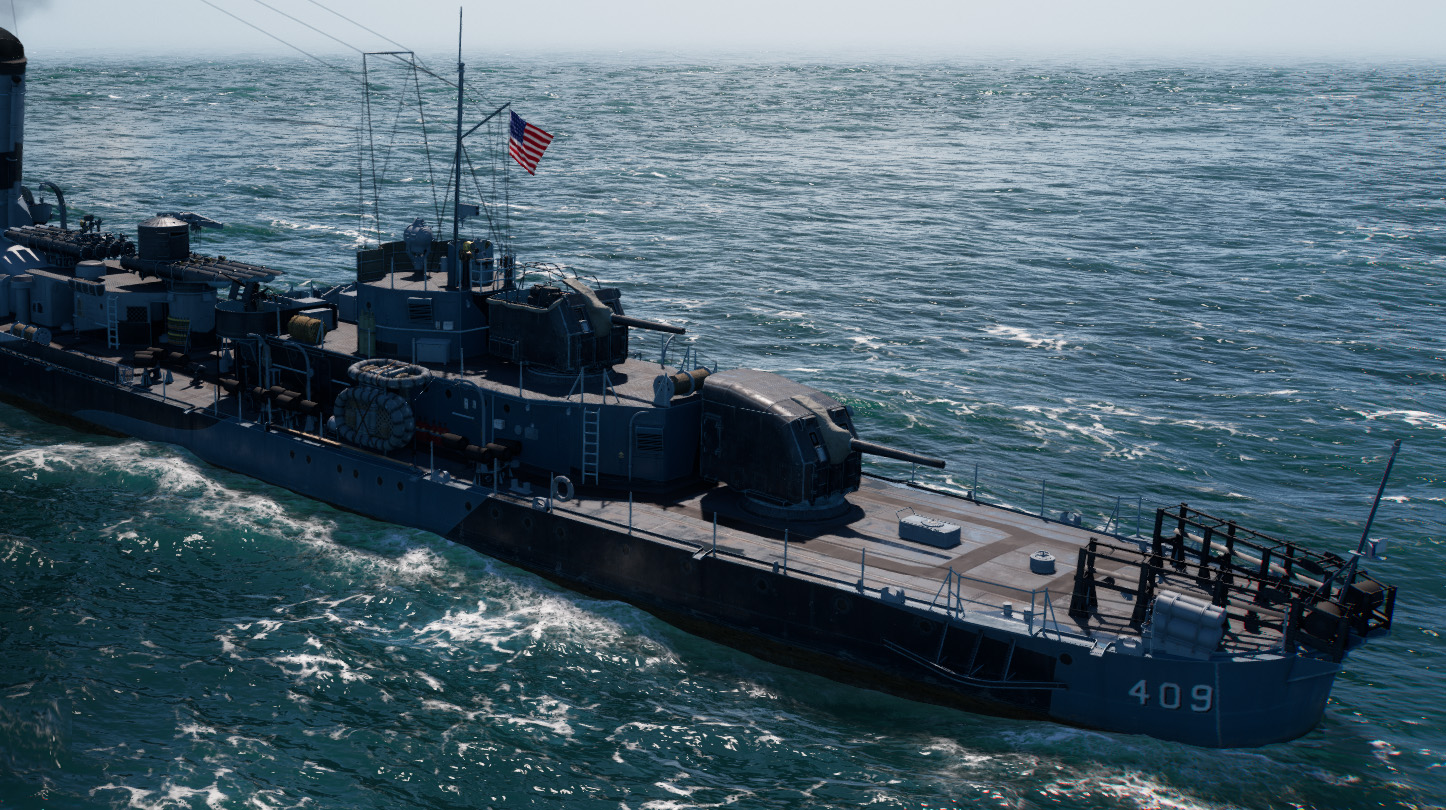
 Latest Facebook Entry -
Latest Facebook Entry -  X(Tweeter) Naval Encyclopedia's deck archive
X(Tweeter) Naval Encyclopedia's deck archive Instagram (@navalencyc)
Instagram (@navalencyc)





 French Navy
French Navy Royal Navy
Royal Navy Russian Navy
Russian Navy Armada Espanola
Armada Espanola Austrian Navy
Austrian Navy K.u.K. Kriegsmarine
K.u.K. Kriegsmarine Dansk Marine
Dansk Marine Nautiko Hellenon
Nautiko Hellenon Koninklije Marine 1870
Koninklije Marine 1870 Marinha do Brasil
Marinha do Brasil Osmanlı Donanması
Osmanlı Donanması Marina Do Peru
Marina Do Peru Marinha do Portugal
Marinha do Portugal Regia Marina 1870
Regia Marina 1870 Nihhon Kaigun 1870
Nihhon Kaigun 1870 Preußische Marine 1870
Preußische Marine 1870 Russkiy Flot 1870
Russkiy Flot 1870 Svenska marinen
Svenska marinen Søværnet
Søværnet Union Navy
Union Navy Confederate Navy
Confederate Navy Armada de Argentina
Armada de Argentina Imperial Chinese Navy
Imperial Chinese Navy Marinha do Portugal
Marinha do Portugal Mexico
Mexico Kaiserliche Marine
Kaiserliche Marine 1898 US Navy
1898 US Navy Sovietskiy Flot
Sovietskiy Flot Royal Canadian Navy
Royal Canadian Navy Royal Australian Navy
Royal Australian Navy RNZN Fleet
RNZN Fleet Chinese Navy 1937
Chinese Navy 1937 Kriegsmarine
Kriegsmarine Chilean Navy
Chilean Navy Danish Navy
Danish Navy Finnish Navy
Finnish Navy Hellenic Navy
Hellenic Navy Polish Navy
Polish Navy Romanian Navy
Romanian Navy Turkish Navy
Turkish Navy Royal Yugoslav Navy
Royal Yugoslav Navy Royal Thai Navy
Royal Thai Navy Minor Navies
Minor Navies Albania
Albania Austria
Austria Belgium
Belgium Columbia
Columbia Costa Rica
Costa Rica Cuba
Cuba Czechoslovakia
Czechoslovakia Dominican Republic
Dominican Republic Haiti
Haiti Hungary
Hungary Honduras
Honduras Estonia
Estonia Iceland
Iceland Eire
Eire Equador
Equador Iran
Iran Iraq
Iraq Latvia
Latvia Liberia
Liberia Lithuania
Lithuania Mandchukuo
Mandchukuo Morocco
Morocco Nicaragua
Nicaragua Persia
Persia San Salvador
San Salvador Sarawak
Sarawak Uruguay
Uruguay Venezuela
Venezuela Zanzibar
Zanzibar Warsaw Pact Navies
Warsaw Pact Navies Bulgaria
Bulgaria Hungary
Hungary

 Bundesmarine
Bundesmarine Dutch Navy
Dutch Navy Hellenic Navy
Hellenic Navy Marina Militare
Marina Militare Yugoslav Navy
Yugoslav Navy Chinese Navy
Chinese Navy Indian Navy
Indian Navy Indonesian Navy
Indonesian Navy JMSDF
JMSDF North Korean Navy
North Korean Navy Pakistani Navy
Pakistani Navy Philippines Navy
Philippines Navy ROKN
ROKN Rep. of Singapore Navy
Rep. of Singapore Navy Taiwanese Navy
Taiwanese Navy IDF Navy
IDF Navy Saudi Navy
Saudi Navy Royal New Zealand Navy
Royal New Zealand Navy Egyptian Navy
Egyptian Navy South African Navy
South African Navy






























 Ukrainian Navy
Ukrainian Navy dbodesign
dbodesign